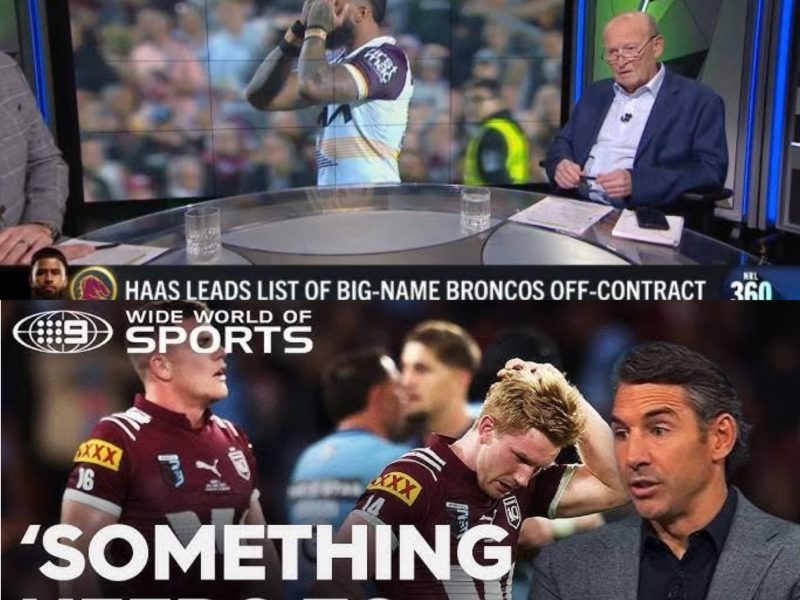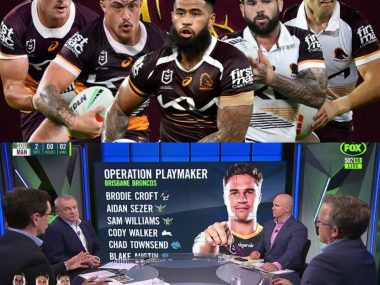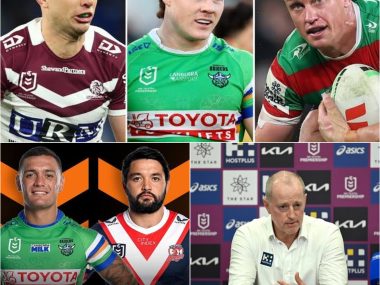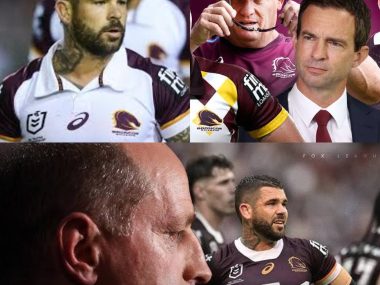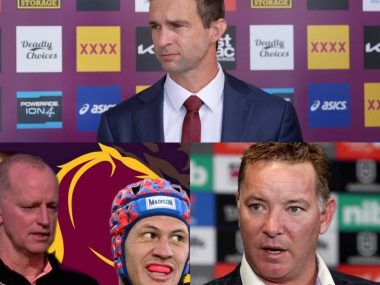Payne Haas may very well be the greatest forward to ever participate in rugby league, but could his achievements be setting him up as a casualty of his own triumphs?
At merely 25 years old, he has already earned the title of Dally M Prop of the Year four times and is likely the first choice for both the New South Wales Blues and Australian Kangaroos representative squads.
However, there lies a dilemma on the club front: Even with Haas statistically recognized as the best front-rower in the sport, the Brisbane Broncos, despite having ample resources, have not secured a premiership.

This poses a difficult question: If five different coaches at the Broncos have been unable to utilize the best prop in the league to win a title for Brisbane, should the organization allocate more funds toward him? Or is it necessary to reconsider the strategy of investing heavily in a forward and instead distribute that salary cap throughout the whole roster?
The dominant front-rower is set to conclude his contract with the Broncos at the close of 2027, and with numerous teams vying for his signature, where might he land?
Haas’ dedication: Deeds versus Statements
Haas has repeatedly indicated his desire to stay with Brisbane. The Broncos took a risk on him during the early stages of his career, supporting him through personal challenges, and he has shown his appreciation in kind.
“I’ve made numerous errors earlier in my career that I now regret, but they’ve stood by me, unwavering,” Haas remarked on Tuesday.
“The only way I can show my gratitude is by striving to secure a premiership. ”
“I have immense affection for the club, and I truly cannot envision myself playing for any other team,” he said. “My real desire is to secure premierships, honestly. ”
However, amidst these sincere sentiments, a troubling truth looms for Broncos supporters: Haas has yet to finalize a new agreement, and his past behavior indicates that his loyalty to Brisbane may not be as solid as it appears.
This situation arose after his agent “accidentally on purpose” listed the front-rower’s name among players open to discussions with other teams once contract negotiations become accessible to all clubs on November 1. In 2022, Haas made a public appeal for a release from his contract. The Broncos turned down that plea, but it raised questions about his allegiance. Almost overnight, he transitioned from a fan favorite to facing boos from Brisbane supporters as he stepped onto the field.

So, does Haas genuinely wish to remain and clinch premierships, or is he merely delivering the expected lines?
Experienced journalist Phil ‘Buzz’ Rothfield believes it leans toward the latter: “What we’ve been seeing in the media is all nonsense. ”
“He’s articulating all the appropriate sentiments,” Buzz remarked in a video on Code Sports. “And his agent is echoing those sentiments because they publicly have no alternative,” he added.
“The Broncos are urgently attempting to restore their status as premiership contenders, and if Payne Haas were to come out now and frankly express uncertainty about his future there, just imagine the backlash that would ensue? ”
In all negotiations, much like in PR situations, individuals involved in high-pressure scenarios tend to publicly express the expected sentiments. I have it from credible sources that his stay is anything but guaranteed.
Interestingly, Haas might not even need to relocate to secure a larger salary, considering that southeast Queensland now features three clubs in the area.
The Wayne Bennett perspective: What is the worth of a prop?
Wayne Bennett, regarded as one of rugby league’s most insightful figures, has often voiced his disapproval regarding high salaries for props.

He previously asserted that a prop should not command more than $300,000 annually. His rationale? While props are essential, they don’t single-handedly secure premiership victories.
Although Bennett’s viewpoint has shifted over time—acknowledging that Payne Haas represents an “exception to the rule”—the fundamental question persists: Is allocating substantial funds for a prop the optimal strategy for assembling a championship-caliber team?
Haas finalized his three-year, $3.5 million agreement in 2023 during the peak of the Broncos’ latest (nearly) successful run, yet the path has been rocky since their grand final appearance that season. They failed to qualify for the finals entirely in 2024 and are currently reeling from a seven-match losing streak in 2025, barely clinging to a spot in the top eight.
Although props like Haas can excel in gaining meters and exhibiting defensive strength, leading teams typically invest more centrally in the spine positions: fullback, hooker, five-eighth, and halfback.
Indeed, Brisbane’s inability to clinch the 2023 premiership—despite having a formidable forward pack that featured representatives such as Haas, Patrick Carrigan, and Thomas Flegler—should serve as a significant lesson for Broncos management: it isn’t solely props who contribute to winning titles.
Moreover, let’s recall who the leading prop was at the Broncos during their inaugural wooden spoon season.
Nonetheless, one cannot undermine Haas’s efforts. He tirelessly endeavors to provide Brisbane with an advantage, averaging approximately 16 hit-ups each match, 920 post-contact meters, and a tackle efficiency exceeding 98 percent in 2025. With stats like these, it’s hardly surprising he holds the title of the highest-paid prop in history.
Even with NRL stars like Reece Walsh and Adam Reynolds on the roster, the Broncos are finding it difficult to achieve consistency this season, despite benefiting from the impact of their dominant front-rower.

This raises an important point: How will various teams perform when a significant portion of their salary cap is allocated to a front-row player? While Payne Haas can potentially secure a victory at his highest performance level, he may not lead a team to a championship.
Perhaps Bennett had a valid perspective after all.
Are stats sufficient?
Haas is undoubtedly an extraordinary athlete. His impressive tally of 920 post-contact meters and nearly flawless tackle success rate highlight his capability to excel in the center.
Nevertheless, simply accumulating meters doesn’t secure premierships. A successful team requires a strong balance, depth, and a dynamic attacking spine to enhance offensive momentum.
Brisbane has demonstrated to the NRL that possessing the top prop isn’t sufficient on its own without effective functioning in essential areas. So, what is the true value in the pursuit of premiership success?
On the other hand, the Warriors, currently tied for the top position on the NRL ladder, boast a forward pack that may not appear star-studded on paper, yet they continue to find ways to secure victories consistently. Even after the loss of their standout front-row player, Mitch Barnett, they were still able to unite and pull off a win.

Likewise, the Canterbury Bulldogs have prioritized investing in their spine—the hot topic of 2025—rather than focusing on their front-row players. Reports indicate that the Bulldogs’ forward pack is primarily on low to mid-range salary tiers, and they understand the importance of collaborating effectively to secure victories.
While Payne Haas may be considered the finest front-row player in history, it begs the question: why allocate even more funds for a ball-carrying prop when that budget could be redirected towards athletes who can convert those yardage gains into points?
Financial considerations: The family aspect
While money isn’t everything, its significance is undeniable. Payne Haas is a father of two and a legal guardian to his younger siblings, introducing an additional layer of complexity to his choices.
He claims that financial incentives are not his leading driver, yet the need for financial security for his family will undoubtedly influence his decision-making.
As reported, Haas could potentially earn up to $1.6 million annually in the open market. Teams like the Perth Bears—preparing to join the league in 2027, which aligns with the conclusion of Haas’ contract with the Broncos—might elevate contract discussions to draw in the New South Wales star.
Haas must determine if his loyalty to the Broncos and his family obligations outweigh the substantial financial prospects available from a different team.
With no agreement finalized at this point, his manager has presented his name, and considering his previous experiences with fan backlash, could this scenario serve as a strategy to mitigate any distractions for the Brisbane club before November 1?
Is Haas so exceptional that he is, in fact, too skilled to secure a premiership?
There is no denying that his extraordinary athletic ability and unwavering work ethic warrant a substantial salary. However, does he end up overextending himself, shouldering the burden for a team that can’t seem to make it past the final hurdle?

If genuine success is his aim, could this translate into a necessary pay decrease? Might this player, often deemed an “exception to the rule,” be hindering both the teams and himself from achieving future premierships?
Ultimately, it is possible that Payne Haas could be too talented to capture an NRL premiership.
